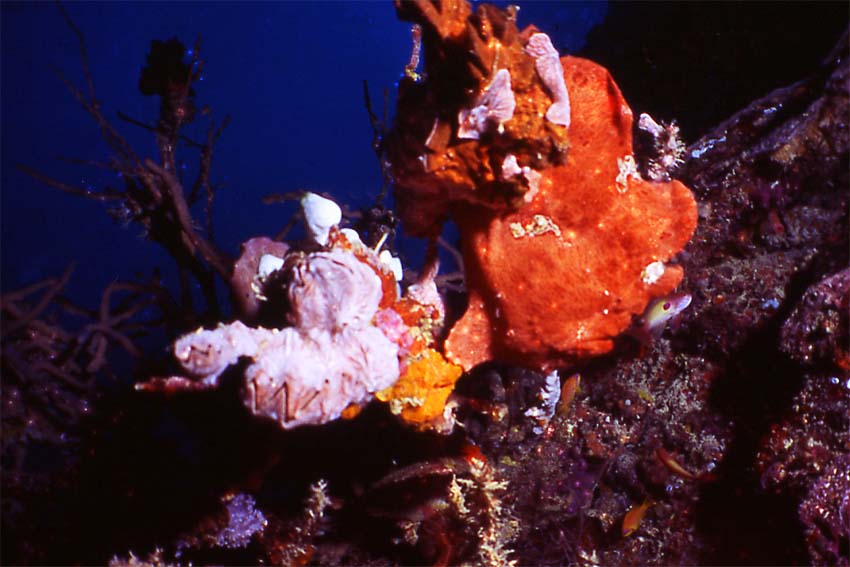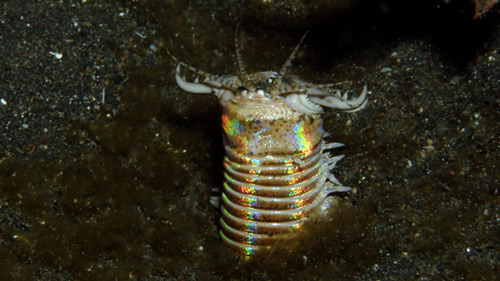Lembeh Strait - Dive Site
Dive sites mainland Sulawesi:
| Dive sites Lembeh island:
| Wrecks:
Dive Resorts / Operators:
|
Lembeh Strait The world renowned Lembeh Strait lies off the northern tip of Sulawesi. Since resorts started to open in the mid-90s the area has rapidly gained popularity amongst macro photographers and is now considered the diving Mecca for critters and macro marine life. The extremely diverse marine habitat in this stretch of water offers a plethora of macro species, many of which can found nowhere else on the planet. Diving here is the ultimate experience for photographers in search of the unusual and unseen. It is often refered to as a muck divers paradise as most of the sites are either sandy areas or small reefs, there are no spectacular walls of drop offs here. With over 30 dive sites to choose from and even a WWII wreck all within a short boat ride over calm waters from the resort it is no surprise that the Lembeh Strait is a world class dive destination.
The world renowned Lembeh Strait lies off the northern tip of Sulawesi. Since resorts started to open in the mid-90s the area has rapidly gained popularity amongst macro photographers and is now considered the diving Mecca for critters and macro marine life. The extremely diverse marine habitat in this stretch of water offers a plethora of macro species, many of which can found nowhere else on the planet. Diving here is the ultimate experience for photographers in search of the unusual and unseen. It is often refered to as a muck divers paradise as most of the sites are either sandy areas or small reefs, there are no spectacular walls of drop offs here. With over 30 dive sites to choose from and even a WWII wreck all within a short boat ride over calm waters from the resort it is no surprise that the Lembeh Strait is a world class dive destination.
Lembeh is diveable all year but the conditions do vary from month to month. January to June sees variable (but still fin e) conditions and less divers. August sees the poorest visibility but the richest numbers of critters and September to October are probably the best two months overall.
e) conditions and less divers. August sees the poorest visibility but the richest numbers of critters and September to October are probably the best two months overall.
The Lembeh Strait has over 30 dive sites so since the topography and marine life is very similar for most of them we have only included the most popular. Other good dive sites in Lembeh include Jahir; a large sandy site with coral blocks, Nudi Retreat; very similar to Nudi Falls, Aw Shucks where whip coral and pipefish are abundant, Pantai Parigi; more muck marine life, Kapal Indah; wrecked cargo boat teeming with life, Jiko Yance; reef slope with good viz, Aer Perang and the house reefs at Kungkungan and Divers Lodge.
LEMBEH DIVE SITES INFORMATION
Police Pier
The sandy shallow slope here has a lot of rubble, trash and things that look out of place underwater. However don't let this put you off, they all make excellent hiding places for all manner of exotic critters. Under the pier itself yo u can expect to see frogfish, seahorses, waspfish, snake eels, cleanershrimp and cuttlefish, also keep a lookout for the endemic Banggai cardinalfish. This is also a great spot for a night dive wherre countless species of crab come out to forage for food and the rare Bobbit worm may be found.
u can expect to see frogfish, seahorses, waspfish, snake eels, cleanershrimp and cuttlefish, also keep a lookout for the endemic Banggai cardinalfish. This is also a great spot for a night dive wherre countless species of crab come out to forage for food and the rare Bobbit worm may be found.
Nudi Falls
A small vertical rock drops into a slope that ends on a grey sandy bottom at 25 meters. As its name suggests the highlight of this dive site are the sheer numbers of nudibranchs that can be found. The soft coral bed houses myriad macro creatures including pygmy seahorses, frogfish and mantis shrimps. The elusive Rhinopias can also be found here though your dive guide is more likely to spot one.
Hairball
This bizarrely named spot is one of Lembeh's more popular. Frogfish sightings here are pretty much guaranteed on this black sand bed of life. This is a true muck dive site with seahorses, octopus, crabs and plenty of other crustaceans. Many of the critters are very well disguised, as algae makes a great camouflage. Close by is Hairball 2 where juvenile batfish, cardinalfish and zebra crabs are seen.
Critter Hunt
Situated at the southern tip if Sarena Kecil Island is this spot which upon first impressions does not look like much. However with the majority of Lembeh's dive spots a keep eye and patience is the key for scattered amongst the rubble and small coral heads are myriad macro critters, hence the name! Keep a look out for decorator c rabs, waspfish, frogfish and squat lobsters.
rabs, waspfish, frogfish and squat lobsters.
Angel's Window
Situated off the north coast of Lembeh Island the submerged peaks here have a number of gorgonians that are home to pygmy seahorses. It is a little different to the rest of Lembeh's muck dive sites, this spot is more like a coral reef dive. Visibility is usually a bit better and there is a couple of swimthrough at about 25 meters which makes up the "Window". Snappers and jacks are often found hanging out here and the walls are lined with crinoids and featherstars.
California Dreaming
This is a nice dive to get a break from all the muck. Colourful coral gardens with large orange tree corals and red gorgonians feeding in the current here. The visibility is also often better that that of the murkier muck sites. There is a plateau at around 14 meters where the critters can be found for those macro addicts that simply cant get enough!
Teluk Kembahu
These dive sites, abbreviated to TK1 and TK2, are named after a local village and are found on the Sulawesi side of the Strait. Topography consists of a dark sandy bottom with scattered rubble and sunken logs. It is where the first mimic octopus was sighted in Lembeh, also the home of the Banggai Cardinalfish which can only be found in this region. No shortage of other marine inhabitants here either with mandarinfish, gobys, devilfish, frogfish, porcelain crabs and razorfish, this is an exceptional dive site.
Mawali Wreck
A Japanese steel cargo ship from WWII was scuttled and sank in 1943. She now lies in 30 to 15 meters of water on her port side. The wreck is around 65 meters long and has heavy coral growth, a number of large lionfish lurk in suspension over the hulk. Spotted baramundi cod are seen along with the usual macro subjects including pipefish, nudibranchs and shrimps. Penetration is no longer recommended due to the heavily encrusted surfaces and instability of the structure.
Bimoli Wreck
Another Japanese freighter from WWII lies on her starboard side in 30 meters of water. Torpedo damage is quite extensive and the wreck is very overgrown and is almost its own mini reef. The wreck starts at 18 meters with the propeller at 30, ammunition can still be seen and very little has been removed. The twisted structure now forms the home of a number of critters such as rock lobster and circling barracuda and tuna.
resources :
www.lombokmarine.com
www.starfish.ch
images :
www.longwoodholidays.co.uk
www.travel.neunerweb.de
www.optimiste.ch
www.sunion.warwick.ac.uk

